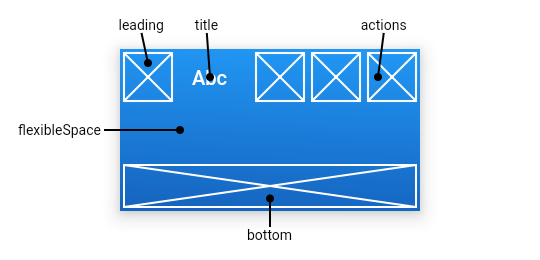import 'package:flutter/material.dart';
void main() => runApp(MyApp());
class MyApp extends StatelessWidget {
@override
Widget build(BuildContext context) {
return MaterialApp(
debugShowCheckedModeBanner: false,
theme: ThemeData(
primarySwatch: Colors.green,
),
home: MyHomePage(),
);
}
}
class MyHomePage extends StatelessWidget {
@override
Widget build(BuildContext context) {
return Scaffold(
appBar: AppBar(
// 左上角的控件,一般放一个icon
leading: IconButton(
icon: Icon(
Icons.apps,
color: Colors.white,
),
// 点击事件
onPressed: () {
print('点击了');
},
),
// 标题
title: Text(
'LOL战绩查询',
),
// 一系列的组件
actions: <Widget>[
IconButton(
icon: Icon(
Icons.search,
color: Colors.white,
),
// 点击事件
onPressed: () {
print('点击了');
},
),
],
// 此小组件堆叠在工具栏和标签栏后面。它的高度与应用栏的整体高度相同
flexibleSpace: Container(
color: Colors.red,
),
bottom: PreferredSize(
child: Container(
height: 50,
width: double.infinity,
color: Colors.grey,
child: Text('bottom'),
),
preferredSize: Size(30, 50),
),
// 最下方阴影部分辐射范围
elevation: 4.0,
// 背景颜色
backgroundColor: Colors.teal,
// 应用栏材质的亮度
brightness: Brightness.dark,
// 设置图标样式
iconTheme: IconThemeData(
//设置图标样式
color: Colors.white,
opacity: 1,
size: 20.0),
// 标题栏字体样式
textTheme: TextTheme(title: TextStyle(fontSize: 20.0)),
// title是否显示在中间
centerTitle: true,
// 配合leading使用,取决于automaticallyImplyLeading == true && leading ==null
automaticallyImplyLeading: true,
// 应用栏的工具栏部分透明度
toolbarOpacity: 1,
// 应用栏底部的不透明程度
bottomOpacity: 1,
// 此应用栏是否显示在屏幕顶部。
// 如果为true,则appbar的工具栏元素和底部窗口小部件将在系统状态栏的高度上填充。 flexibleSpace的布局不受主要属性的影响。
primary: true,
// 横轴上标题内容 周围的间距。即使没有前导内容或操作,也会应用此间距。如果希望 title占用所有可用空间,请将此值设置为0.0
titleSpacing: 0.0,
),
body: HomeContent(),
);
}
}
class HomeContent extends StatelessWidget {
@override
Widget build(BuildContext context) {
return Center(
child: Column(
mainAxisAlignment: MainAxisAlignment.center,
children: <Widget>[
Text('',
style: TextStyle(
fontSize: 40.0,
fontWeight: FontWeight.bold,
color: Colors.green)),
],
),
);
}
}




